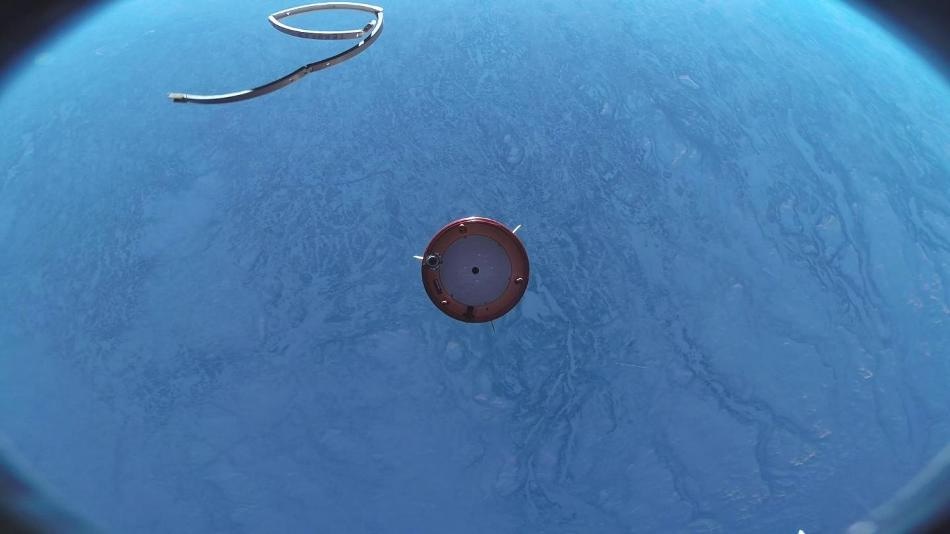Nov 18 2016
 This view of Earth from the research rocket shows the detachment of the last booster -- the moment when the optical clock began operating under microgravity. (Credit: Airbus Defense & Space GmbH)
This view of Earth from the research rocket shows the detachment of the last booster -- the moment when the optical clock began operating under microgravity. (Credit: Airbus Defense & Space GmbH)
An optical clock has been tested in space for the first time. This technology endured harsh rocket launch conditions and effectively operated under the microgravity, which would be experienced on a satellite. This latest breakthrough brings us closer to implementing optical clock technology in space, where it could ultimately enable GPS-based navigation with centimeter-level location precision.
Researchers have developed a compact, automated, and robust frequency comb laser system that was critical to the operation of the space-borne optical clock. Frequency combs are a major component of optical clocks as they act like “gears” and are required to run the clocks ticking at optical frequencies. The results of the study have been reported in the Optical Society's journal for high impact research, Optica.
Our device represents a cornerstone in the development of future space-based precision clocks and metrology. The optical clock performed the same in space as it had on the ground, showing that our system engineering worked very well.
Matthias Lezius, Menlo Systems GmbH
Using time for Location
GPS-enabled devices, including phones, indicate a person’s location on Earth by contacting no less than four satellites bearing atomic clocks. Each satellite offers a time stamp, and based on the relative differences among those times, the system measures the person’s location. Today’s satellites use atomic clocks that are built on the natural oscillation of cesium atoms, a frequency present in the microwave area of the electromagnetic spectrum.
Atoms or ions used by optical clocks oscillate approximately 100,000 times higher than that of microwave frequencies, in the visible or optical part of the electromagnetic spectrum. Such higher frequencies mean that optical clocks are able to “tick” faster compared to the microwave atomic clocks, and could offer time-stamps that are 100 to 1,000 times more accurate, considerably improving GPS precision.
Frequency combs are gears that divide the faster oscillations of optical clocks into lower frequencies, so that they can be counted and connected to a microwave-based reference atomic clock. That is with the help of the frequency combs, the optical oscillations can be precisely calculated and used to tell time.
Until recently, only laboratories had the large, complex set-ups of frequency combs. At Menlo Systems, a spin-off company of Nobel Laureate T.W. Hänsch’s group at the Max Plank Institute for Quantum Optics, Lezius and his team created a fully automated optical frequency comb that weighs 22 kg and measures just 22 x 14.2 cm.
Built on optical fibers, the novel frequency comb is robust enough to travel through the harsh temperature changes and acceleration forces that are experienced on leaving Earth. It consumes less than 70 W of power, which is well within the needs for satellite-based devices.
Traveling to Space
The novel frequency comb was combined with an atomic cesium clock for reference as well as a rubidium optical clock created by researchers at Humboldt University of Berlin and Ferdinand Braun Institute Berlin, and also by researchers from the University of Hamburg that recently relocated to Johannes Gutenberg University of Mainz (JGU).
Airbus Defense & Space GmbH supported the construction, integration, and interfacing of the payload module that traveled into space, and also provided equipment and support during the flight.
In April 2015, the whole system was sent to space through a research rocket flown for a 6-minute parabolic flight. This was part of the TEXUS program that launches from the Sweden-based Esrange Space Center. After achieving microgravity, the system automatically started measurements and was effectively controlled from the ground station through a low-bandwidth radio link.
The experiment demonstrated the comb's functionality as a comparative frequency divider between the optical rubidium transition at 384 THz and the cesium clock providing a 10 MHz reference.
Matthias Lezius, Menlo Systems GmbH
While the optical clock used in the study possesses one tenth of the accuracy of atomic clocks used on today’s GPS satellites, the team is already working on a novel version that will enhance the accuracy by several orders of magnitude.
Global Sensing from Space
The accurate measurements achieved with the frequency combs could be useful in a wide range of applications. Space-based frequency combs, for instance, may enhance the accuracy of global remote sensing of greenhouse gases from satellites and may even be used for gravitational wave detectors based on space.
Applications based on frequency combs are quite important for future space-based optical clocks, precision metrology and earth observation techniques. The space technology readiness of frequency combs is developing at a fast pace.
Matthias Lezius, Menlo Systems GmbH
The research team is aiming to fly a better version of the optical clock into space towards the end of 2017. However, in that experimental study, the frequency comb module will not be allowed to fly under a pressurized dome to test the way it works in the vacuum conditions that would otherwise be experienced on a satellite experienced on a satellite.
The team is also looking for ways to improve the system’s resistance to extreme cosmic radiation so that it can function for a number of years in orbit.
Within a period of few years, Lezius and his research team are aiming to build a space-qualified frequency comb module that can be used in future missions and applications by the space community. They are planning to create a device that weighs a few kilograms, has a volume of about 3 L, and consumes a power of 10 W.
Source: http://www.osa.org/